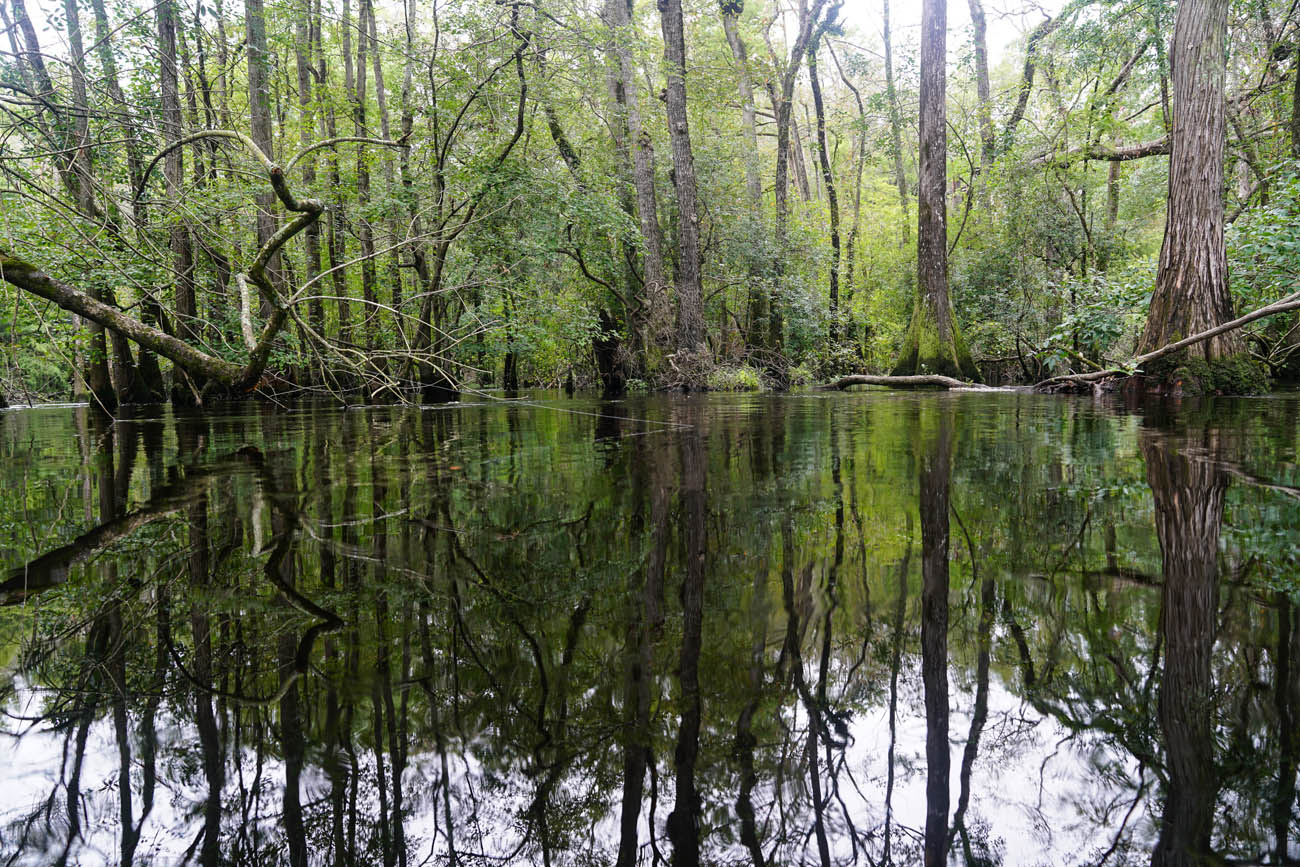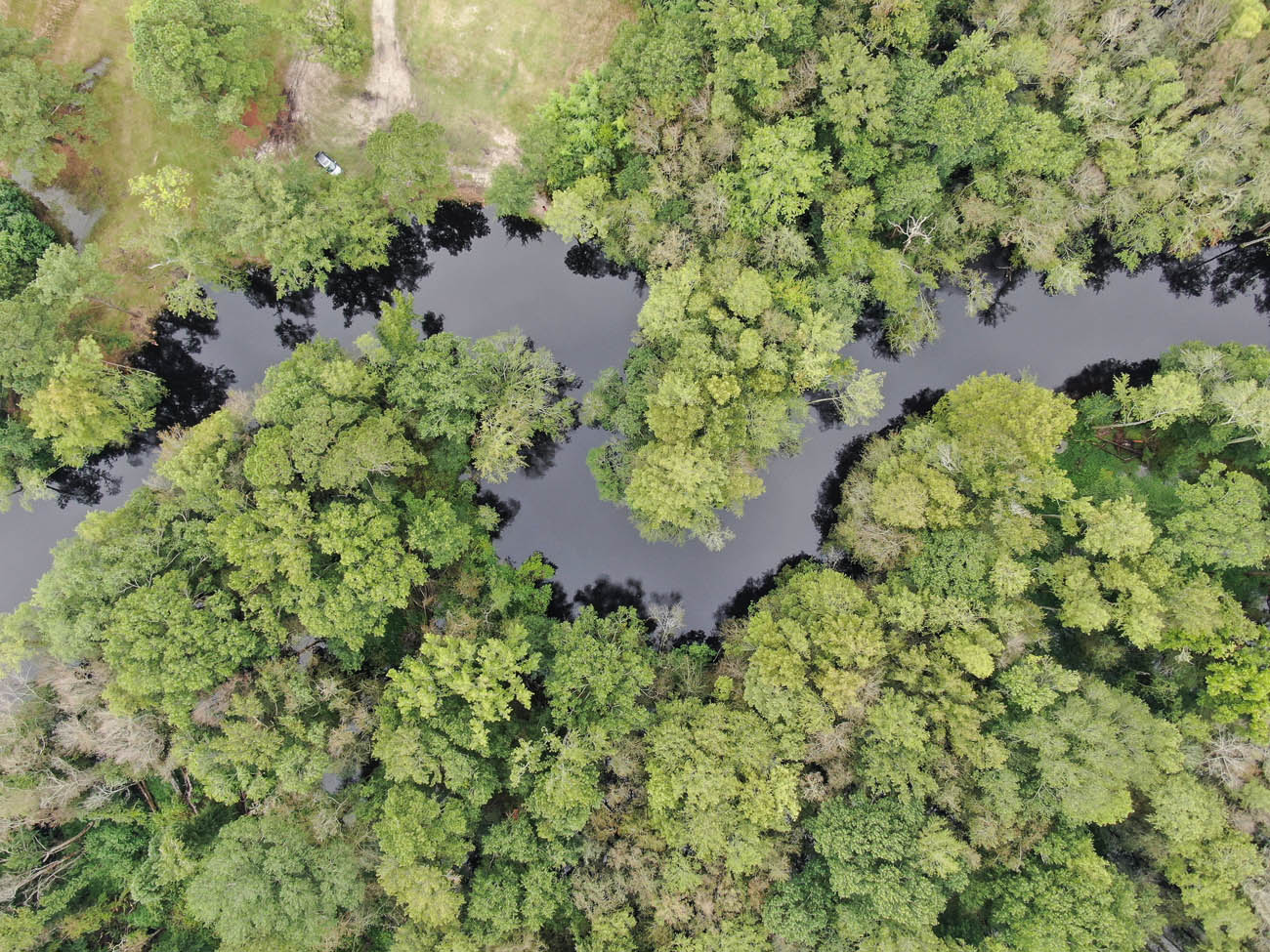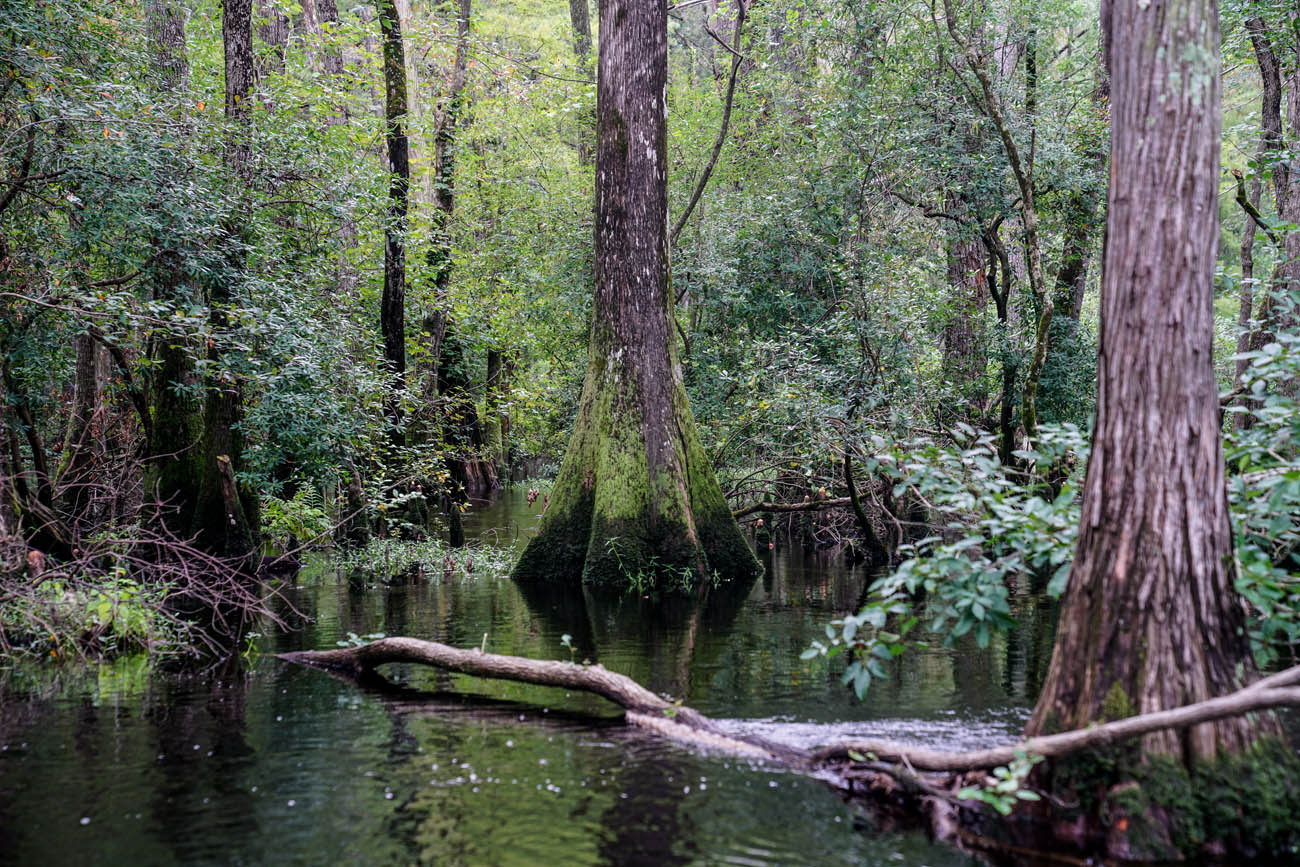For many in Robeson and Scotland counties, the land along the Lumbee River is a source of pride, a catalyst for environmental activism, and a resource to effect change. In part I of this two-part look at the region’s environment Jorden Revels, a university student, environmental activist, and member of the Lumbee Tribe, discusses the importance of the local landscape to Lumbee identity and demonstrates how lifting up Indigenous youth voices can create liberatory environmental movements. —Morgan Augillard and Joey Swerdlin, Along the Lumbee River report editors
Read From Prison to Farm: Lifting Up a New Generation, part II of our look at “Getting Reacquainted with the Land.”
The following has been excerpted from interviews conducted by the report editors.
The text has been edited for length and clarity.
Beginnings (Realizations and Coming to the Work)
Chicken and hog trucks. I thought that was just so common growing up, seeing them probably a few times a week. You would have to drive past one of the plants, and of course it smelled terrible. I just thought it was just a very common thing. I realized that’s not normal. That is not normal. Other people don’t have to deal with that crap. When it came to the dynamics in our area, I suffered from just wanting to get away because of how problematic the area was, with just how many environmental and social issues riddled the community, but I realized that’s another thing that harms us. There are folks who do have the resources and skills to support the community, but with the compounding effect of brain drain they decide not to do so because of how problematic it is.
I originally got started in the environmental justice movement way back before my innocence was taken by the world and just everything that’s going on right now. In 2016—I was 18 years old, a freshman in college—you know, you heard about all the momentum around the Dakota Access Pipeline. In a sense, I feel like that was a shifting moment for a lot of Native communities across the country. This issue was getting widespread recognition and support from all types of sources, and it really changed the narrative on how a lot of our issues tend to be faced. So eventually, in the fall of 2016, I was hearing about something called the proposed Atlantic Coast Pipeline (ACP), which was a pipeline project that was set to terminate in Robeson County. Coming off the tail end of the Dakota Access Pipeline situation, I was like, “Wait a second, we got something like this happening in our own backyard?”
I was in student government and passed legislation coming out against the proposed ACP, and I did a lot of follow-up work: setting up booths, tables, helping educate students about the pipeline, as well as giving them the opportunity to write to their legislators about this issue and tell them, “You need to stop this project immediately.” Luckily, through that work I attended a pow-wow at the schoolhouse, and one of our tribal elders, Donna Chevis, had just attended the ACP walkout. We got to talking and she connected me with her husband, Reverend Mac Ledgerton, who reached out to me about an internship opportunity during the summer.
That summer, I worked as a Z. Smith Reynolds Foundation intern, and I was paired up with an organization called Appalachian Voices, which really got its start helping fight against coal ash issues with BIPOC communities in poor communities in Appalachia. There, I was able to do a lot of work on the proposed ACP, and do so in an intersectional way with scholars from my tribe, community leaders, and folks who had been doing this work for 30-plus years. I got a deeper understanding of not only issues of environmental justice, but also the specific issues that affected my community.
There was one very special moment that I experienced [that grounded me in this work]. I was on the Lumber River1This report has chosen to use the name Lumbee River to honor the name that the Lumbee Tribe of North Carolina officially uses. Lumber River, however, is still commonly used. leading a class of UNC Chapel Hill students down with Rev. Mac Legerton and Dr. Ryan Emanuel, a Lumbee scholar at NC State. Rev. Mac Legerton was giving a kind of historical, spiritual perspective of how the river, these waterways, and the environment has shaped and crafted local Native history. Dr. Emanuel was giving the ecological perspective and talking about how these wetlands and water sources would be damaged by the ACP. It was in that moment, as I was kayaking down the river, I experienced something that one Native colleague explained to me as genetic memory. In a sense, genetic memory is participating in the same actions, the same activities that your ancestors did, which evokes an indescribable moment. In that moment, everything just clicked, and I understood it was more than just the environment that was at stake. It was our health. It is our well-being. Our very future was on the line, and our identity was being threatened by this project.
When you look at Native history, Native tribes, every tribe has a unique relationship to their landscape. For folks out in the Southwest like the Pueblo people, their pottery came from the earth and influenced trade, their history, and their interactions not only with other tribes, but with settlers. With our tribes, the Lumbee are known as the People of the Pines or the People of the River because we depend so heavily upon it; it has shaped our very livelihood. So for those resources to be threatened and at risk of not being accessible to future generations, that is inherently a threat to our identity.
It really started rotating all these gears for me and got me to understand the importance of environmental justice and how it’s so much more than just about the environment. It’s racial justice; it’s restorative justice; it’s climate justice. It’s all of these different inequalities intersecting and coming to a head. So for me, that’s what really hooked me in and got me to understand the importance of the work as well as helping others do the same.
Understanding Robeson County (People, Place, and History)
It’s pretty tragic and depressing. We, along with a lot of other rural, low-income communities, not just in North Carolina but across the country—and other BIPOC communities across the world—are labeled as “sacrifice zones.” We all take the brunt of these projects and their effects for the “greater good of society.” For example, if you look at the one common denominator across toxic waste projects across the entire country, a lot of people would think, “Oh, it’s socioeconomics; it’s class that’s defining these zones.” But poor white folks aren’t going to be affected just the same. Research has shown that the one determining factor in defining a sacrifice zone is race.2Robert D. Bullard, “Environmental Justice in the 21st Century: Race Still Matter,” Phylon (1960-) 52, no. 1 (2015): 72-94. The FDA basically regards Robeson County as a community that is designed to fail. That has been very intentional. It is a constant extractive process settler colonialism has placed on BIPOC communities.3Clean Water for North Carolina, “Robeson County Is NOT A Sacrifice Zone – Go Home, Active Energy,” Clean Water For North Carolina, July 2, 2020.
Robeson County was uncharted on maps up until 1880. That is because a lot of our area was swamplands. Native folks—Native folks of mixed heritage, not just between different tribes, but mixed with Black and white heritage too—originally came here to hide out in these swamps to get away from colonization and other issues they were facing. The white folks weren’t going into the swamps. They didn’t know how to navigate them or thrive in that area. It wasn’t until colonialism went on and further development happened that people started settling into these areas.
This connects to the environmental issues we have now. We lie on a hundred-year floodplain and it’s very, very easy for our areas to flood. The land is naturally designed to do this. Even more so when you take away the trees to make way for more development projects and more settling. You’re taking away the one thing that’s keeping the water in the ground in these swamplands.
In this way, our issues aren’t just manmade in the sense of the effects of natural gas pipeline infrastructure projects or fossil fuel use in industrial agriculture—something you’ll see in rural areas of North Carolina, but not in places like Raleigh and Durham—but also because we’re in vulnerable locations where the natural processes of the land have been exacerbated as a result of the climate change. It’s kind of like a double whammy. And you’re not only having to face what’s happening right now, but the ramped-up effects of the climate crisis. Just from Hurricane Matthew, there was a designated 10-year recovery period, and then we got hit with another major storm, Hurricane Florence, two years later. All of these compounding issues are battering down on people, on their morale, on their literal health and well-being. This is on top of current health disparities we already face, such as increased cancer and asthma rates in certain pockets of the community.4Thomas Goldsmith, “In Robeson County: Fighting Grim Statistics with Work and Hope,” North Carolina Health News, November 28, 2016.5North Carolina Institute of Medicine, “Robeson County,” North Carolina Institute of Medicine, 2020. All of these different things come together and relate back to greed and extraction.
When it comes to settler colonialism, the Southeast region of the US was affected by colonization for a hundred years before folks were out west. So unfortunately, a lot of our communities do come from colonized backgrounds, and some of them just don’t believe in issues such as climate change. Some of them don’t even believe we’re going through a pandemic right now as a result of assimilated settler-colonial politics dictating their beliefs. That’s the reality we have to work against. But there has been that gradual perspective shift. The older generation has more of the mentality that, “We cannot do anything, we just have to sit back and pray about it,” but that has been going on for generations, and the only way things will change is if we back it up with action.
Jorden Revels discusses life and politics in Lumbee nation in more detail on the Red Nation Podcast, where he is joined by Lumbee scholar Dr. Malinda Maynor Lowery.
For a lot of folks, the land and farming is in their blood. Their property and their practices have been passed down from generation to generation. For those older folks, it’s hard to get them to see the problematic nature of how we’ve gone about agricultural practices and land use, especially with the growth of industrial agriculture. Some folks get it completely because they’re the ones who are caretakers of the land and have the most respect for it. Others just think, “Hey, economic development is economic development. It doesn’t matter what it looks like as long as we are getting resources.”
What we’re trying to emphasize with our work is, yeah, we do need money, but at what cost? Where do we draw the line between what we need to secure in the short term versus what will be best for us in the long term? What is going to be the impact of these decisions for later generations? Which, thankfully, some of the older generations are actually very much on board with the concept of seven generations. The “seven generations” is an Iroquois concept that says everything we do must be done in consideration of its impact on the next seven generations. But there is a divide in trying to decide what’s good for folks and what’s not, especially when folks, again, have been preyed on within the community for so long, denied economic prosperity due to globalization, and other policies that have negatively impacted us as Native peoples.
A lot of the people who grew up in the community tend to do so without the same resources and skill sets as other people who are coming from outside. Part of it goes back to education; another part is the negative aspects of just communal culture in rural America—a lot of folks don’t feel the need to have a voice. They don’t see themselves as particularly having anything of significant contribution to share, or they are afraid of confrontation. But I can tell that as a result of the work that I and others have done, that we’re helping basically develop those pathways of self-empowerment, self-discovery, and helping them to find that voice they do have and get involved with issues they find themselves caring about.
I see my role as being the person who helps get conversations around youth engagement and increasing representation of rural, BIPOC, low-income residents within environmental and climate justice movements in our area. A lot of time those are the groups that are left out of environmental justice conversations, as well as any considerations for grants, resources, or programming. I see myself as being the one who is able to get some foundations to help my generation and future generations pick up this issue and carry it forward.
Our folks are becoming more radicalized. Not just with the environmental justice concerns that folks are having, but also with race issues, and with issues pertaining to missing, murdered Indigenous women. We’re having those tougher conversations in the process of decolonization as a result of the shifts that are happening. I think a lot of people are starting to get to it, honestly.
Centering Native Identity
We [the Lumbee] are an agricultural-based tribe. Many of our ceremonies fall on the dates of solstices, as those days were always revered as dates that gave us our life. With that comes respect for not only crops but the land on which the crops grow and everything else that encompasses those ecosystems. These ceremonies are not just from our current lived culture and tradition, but also from the older traditions, which are slowly starting to fade away due to colonization. We try to at least center ourselves in the thought that we are the same as other animals on this planet. We’re not above nature in any capacity; we are a part of it. We’re an active part of these ecosystems, and we choose whether or not to be a benefit or detriment to those environments we live within.
The history of Lumbee people [is tied to fighting for the right to this land]. One of our historical legendary figures, Henry Berry Lowry, led the Lowry Gang. It was made up of Natives, Black folks, freedmen, poor white folks, or people who were from the Union.6“History and Culture,” Lumbee Tribe of North Carolina, Lumbee Tribe of North Carolina, 2019. They banded together and actually pushed back against the Confederates that occupied the area at the tail end of the Civil War. This group pushed against a large, not just abstract force but literal, physical force that was threatening them and the well-being of their community.
That’s been a persistent concept throughout our history—from the point of when we came to this area and escaped colonization for a bit, to Henry Berry Lowry, to the establishment of the Croatan Indian School which is now UNC Pembroke, and where we are today. There has always been that constant concept of resistance and pushing back against those larger forces that are detrimental to our communities’ well-being. It’s ingrained in us, whether we realize it or not, the inherent drive of resistance to those forces. Learning more about that history and what resistance looks like for the Lumbee community has informed my values, practices, and the way I go about operating with my activism.
For me personally, it goes beyond just protecting waterways, flora, and fauna in an area. My calling as a land protector for my people goes back to the concept of trying to decolonize for my folks. A concept that’s used in Native communities is “land back.” It goes beyond just physically getting our land back, but also the figurative and abstract concepts of reclaiming our identity, protecting it, and ensuring it’s protected for future generations. It goes back to that concept of land as identity, and loss of land equals loss of identity. It goes beyond just looking at land as a commercial product that you could just easily exchange. It’s a more traditional perspective of how Natives view the concept of land. “Property” was not in our language or realm of conceptualization until colonization happened. Being a land protector is all those things and is a traditionalist way of acknowledging my role and what I am protecting in the current day in a contemporary setting. It goes beyond just protecting the physical environmental land, but that land as our identity, and our identity as our well-being and health.
Biographies
is a senior at the University of North Carolina at Pembroke, majoring in psychology and American Indian studies. Revels also works with nonprofit organization NC WARN, helping local youth gain a deeper understanding of climate and environmental justice.
The views expressed here are those of the authors only and do not reflect the position of The Architectural League of New York.




